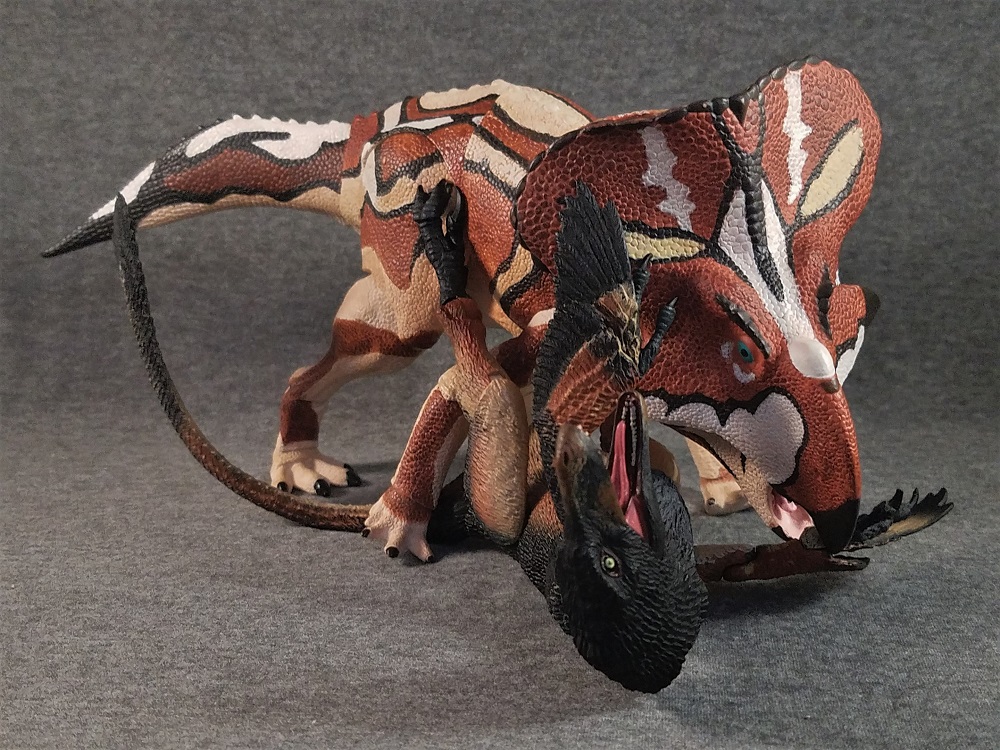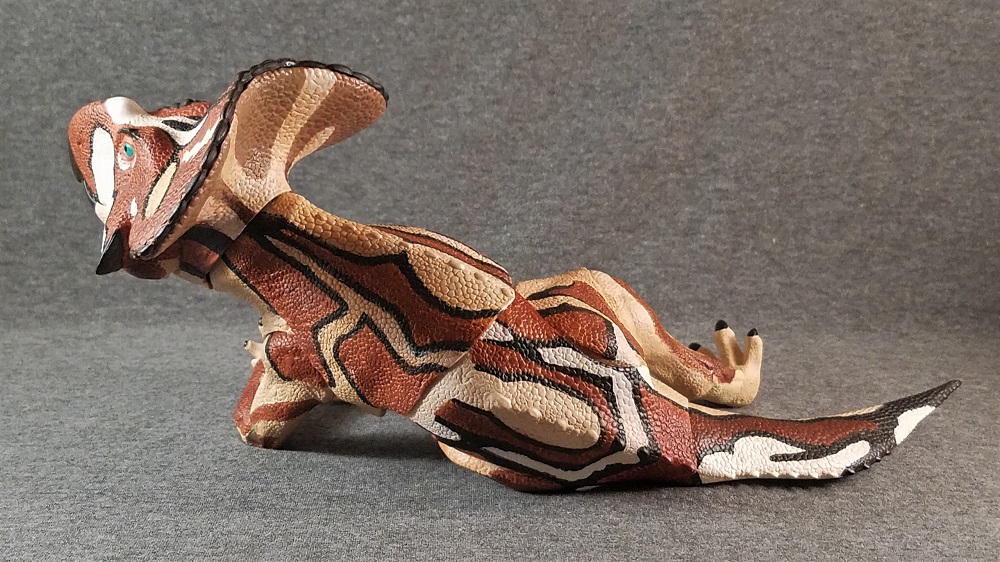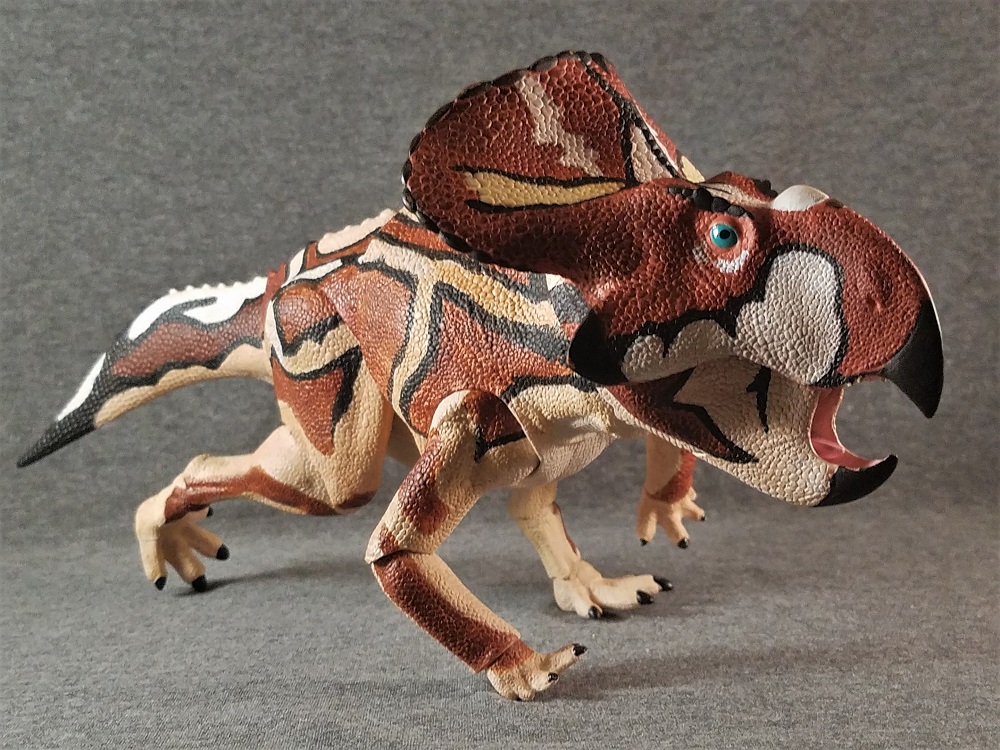A famous story, an ancient tragedy, a spectacular discovery. Two dinosaurs, locked in lethal combat, suddenly perished from external forces, their bodies preserved almost perfectly in their last moments of action. What was cause of the combat and demise? Paleontologists have speculated long and hard since the year 1971, when an expedition to the Gobi Desert led to the discovery of the fossil now renowned as “The Fighting Dinosaurs” – a Protoceratops with its sharp beak grasping the arm of a Velociraptor, whose sickle claw is embedded in the herbivore’s neck. Did the theropod pick a bad fight with a bigger prey animal? Did the herbivore go into preemptive attack to defend a nest or herd mate? Did quicksand or a collapsing sand dune bring about the animals’ simultaneous deaths? We wonder and imagine to this day.

The discovery of the Fighting Dinosaurs was a big break for Velociraptor, which had previously been known from only a few fragments; but Protoceratops was already a very well-known dinosaur in both scientific circles and popular culture. Since its description in 1923, Protoceratops andrewsi (Roy Chapman Andrews’ first horned face) has had numerous fossils and skeletons found to its name, and was frequently featured in literature and museum exhibits. Although Velociraptor has certainly won the war of popularity since the release of Jurassic Park in 1993, Protoceratops still frequently gets its due – often pitted against the swift theropod in an iconic fashion paralleling the famous T. rex-vs-Triceratops feud.

It’s only natural Protoceratops would feature in the Beasts of the Mesozoic line, the dream project of toy designer David Silva and his independent company, Creative Beast Studios. Released in 2020, Protoceratops is no. 08 of the Ceratopsian series, marked 1/6 scale (as opposed to 1/18 like most of the series; David Silva has since produced a 1/18 version as well). Like all Beast of the Mesozoic figures, the dinosaur figure comes packaged in a sturdy box with a large window an a side sleeve, with factual data and lovely promotional artwork (produced in this case by Raul Ramos). On the back of the box each of the “wave 1” ceratopsian figures are illustrated as a checklist. Inside the box is a collectible card and a removable display backdrop. No stands or bases are included.

The Protoceratops figure measures 32 cm (12.5 in) straight from nose to tail, or closer to 36 cm (14 in) when accounting for the curvature along the spine. Both of these lengths put the figure in the ballpark of the advertised 1/6th scale for 1.8-meter specimen, which is the “official” size stat on the sleeve. The figure is designed in near-perfect likeness of the living creature’s known anatomy. We know Protoceratops’s skull was subject to variation based on age, and possibly gender and individuals; but the figure’s skull matches the features of an “idealized” adult (potentially a male), with a pronounced nasal ridge and a wide frill that extends back from the skull at about a 30-degree angle. The beak is massive, hooked, and sharp – perfect for clipping plants and theropod limbs. A pair of teeth are sculpted on each side of the upper beak, matching the distinct tooth sockets found in fossils. The jugal horns are well-defined, and reinforced scales highlight the brows and the frill’s rim. Most of the frill is covered in irregular circular scales, just like the rest of the face and body, with excellent textural detail.

Protoceratops looked big compared to a dromaeosaur, but was less robust in body than its larger relatives. The figure captures the animal’s long limb proportions very accurately, as well as the sloped body posture and modestly long tail. The neural spines are tall, capturing the somewhat flag-shaped appearance of the fossils – although the arch of the back might be a bit conservative. A single row of speculative dorsal scales runs from the neck down to the end of the tail as an extra touch to the silhouette, however. Five toes on the front feet and four on the back, all separate and splayed, are correctly accounted for. The torso could perhaps be reconstructed a little deeper (a sacrifice for articulation, perhaps?), but the neck is appropriately deep to anchor the voluminous head and frill.

There are 18 advertised points of articulation to the Creative Beast Protoceratops. The mouth can open wide enough to fit a human finger inside (careful!), but doesn’t close with the beak fully flush. A ball joint at the base of the skull allows the figure to look in most directions, although a second joint in front of the shoulders would have benefited the figure greatly. The shoulders themselves, and the wrists, are also ball joints, with swivel/hinge joints for the elbows. The hind legs are engineered basically the same at the hips, knees, and ankles. With proper balancing, the figure can pull off a lot of poses; my only qualms are that the knees sometimes feel restrictive, and the feet are stuck in a planted shape which can mar the image of a running dinosaur somewhat. All in all, the articulation is satisfactory, though. A ball joint in the torso and another at the base of the tail are also welcome.


Beasts of the Mesozoic has been complimented and criticized for the choices of striking color schemes applied to the dinosaurs: they’re very colorful, but maybe too colorful for some collectors’ preferences, and a little too on-the-nose with modern animal parallels. Protoceratops in particular has born the weight of some teasing, due to its thorny devil lizard coloration coming out looking like… fresh bacon? Your mileage may vary. Technically speaking, the figure is basically trichromatic in color, so the paint job isn’t as literally vibrant as some other horned dinos in the line. The stark light-and-dark striping is certainly eye-catching, though, at least when displayed on a shelf. Out in the Mongolian desert of sand and rock, however, these rusty reds and tans might have assisted the animal in being less noticeable to would-be predators. The application is excellent, too – no slop, clean stripes, neat green eyes, and a very faint wash to bring out the definition of every scale. The only flaws are a few tiny scuffs around the horns and toes, either from packaging or minor display wear.

Protoceratops has pretty solid representation in toy & collectible form, but few items have as much shelf presence as the Beasts of the Mesozoic line commands. With over three different Velociraptors available from the line’s raptor series, it’s only fair their favorite dueling partner should get an action figure of its own. Creative Beast Studios have delivered another impressive product with the first horned face, and it’s sure to please any dinosaur fan. The Protoceratops can be purchased directly from the Creative Beast Website, as well as associated retailers like Everything Dinosaur and Happy Hen Toys.

Support the Dinosaur Toy Blog by making dino-purchases through these links to Ebay and Amazon. Disclaimer: links to Ebay.com and Amazon.com on the Dinosaur Toy Blog are often affiliate links, when you make purchases through these links we may make a commission

Ez egy csodás értékelés,egy csodás figuráról.A színéről annyit,hogy baconceratops,de amúgy csodás,tényleg!
The two dinosaurs look amazing in their fighting pose!
@dinotoyblog it looks great, even though the color scheme makes me think "oh, look, a dinosaur made of bacon!"
Ha! Yeah, that ‘bacony’ appearance is there in the 1:18 version as well: https://dinotoyblog.com/protoceratops-andrewsi-beasts-of-the-mesozoic-118-by-creative-beast-studio/
@llewelly @dinotoyblog Funny, I thought it was exactly the colouration and patterns of large silkmoths like cecropia and sphinx.
@Akki @dinotoyblog
oh, it does, especially Cecropia, but I didn't think of that.
@dinotoyblog Great review and pictures @fembrogon